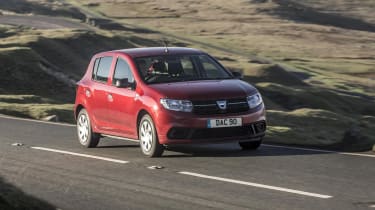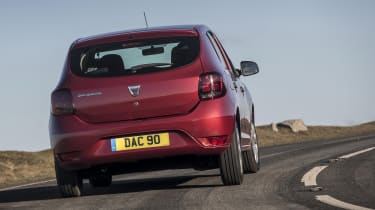Dacia Sandero hatchback - Engines, drive & performance (2013-2020)
The Dacia Sandero hatchback is very comfortable, but it’s no sports car
The Dacia Sandero was clearly developed for comfort and ease of driving rather than sheer entertainment. The steering is a little heavier than most of its rivals around town, but this doesn’t translate into greater feel on the road. All told, while perfectly pleasant from behind the wheel, with more than enough grip from the tyres and a predictable, safe feel, the way the car leans in corners and some occasional ‘kickback’ through the steering discourages you from pushing too hard on a twisty road.
The only difference between the two petrol engines is the amount of power they offer – they both weigh around the same and this means you can barely tell them apart unless you really put your foot down.
As a car intended to earn its keep for providing fuss-free family transport, too much enthusiasm in corners will only spoil your passengers’ enjoyment anyway. Ease off the accelerator, though, and they’ll appreciate the way the Sandero effortlessly soaks up bumps. For such an inexpensive car, the Sandero is a thoroughly comfortable way to pass the miles. It’s not too noisy inside, either – the tyres don’t kick up much racket and the rush of the wind is muted, too.
More reviews
Although some superminis come with automatic gearboxes, there isn't one available on the Sandero. Only a five-speed manual is offered and while it’s a little notchy in use, it’s acceptable enough for the price.
Dacia Sandero petrol engines
As the cheapest engine option, the 74bhp SCe 75’s 0-62mph time of 15.1 seconds is slow but not unexpected. It’s still a pleasant engine to drive and feels as responsive as some engines with more power.
It has to be worked harder than the more powerful engines, though, and this has a detrimental effect on fuel economy. It’s also a little more prone to vibration but does have a surprisingly characterful sound.
Sitting in the middle of the Sandero engine range is the turbocharged 0.9-litre TCe 90 petrol. With three cylinders, it makes a characterful thrumming noise that never gets intrusive, particularly as its high gearing means engine revs stay low at motorway speeds. A total of 89bhp and 0-62mph in 11.1 seconds makes safely merging with motorway traffic easy. Apart from a tiny bit of lethargy when you first put your foot down, it’s a responsive engine. You have to be quite gentle with the accelerator, though, because the turbocharger’s boost comes in quite abruptly.
Those opting for the range-topping TCe 100 Bi-Fuel 1.0-litre engine are likely to be impressed by its improved pulling power over the TCe 90 engine. It’s also the most powerful engine available in a Sandero, with 99bhp. Despite the extra power, it doesn’t offer any real performance gains, taking 11.5 seconds to reach 62mph regardless of whether you're running it on petrol or LPG.














